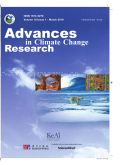- 钛学术文献服务平台 \
- 学术期刊 \
- 基础科学期刊 \
- 天文学、地球科学期刊 \
- 气候变化研究进展(英文版)期刊 \
Deep learning projects future warming-induced vegetation growth changes under SSP scenarios
Deep learning projects future warming-induced vegetation growth changes under SSP scenarios
基本信息来源于合作网站,原文需代理用户跳转至来源网站获取
摘要:
Climate warming has been projected to enhance vegetation growth more strongly in higher latitudes than in lower latitudes,but different projections show distinct regional differences.By employing big data analysis(deep learning),we established gridded,global-scale,climate-driven vegetation growth models to project future changes in vegetation growth under SSP scenarios.We projected no substantial trends of vegetation growth change under the sustainable development scenario(SSP 1-1.9)by the end of the 21st century.However,the increase of vegetation growth driven by climate warming shows distinct regional variability under the scenario representing high carbon emissions and severe warming(SSP5-8.5),especially in Northeast Asia where growth could increase by(6.00%±4.21%).This may be attributed to the high temperature sensitivities of the deciduous needleleaf forests and permanent wetlands in these regions.When the temperature sensitivity that is defined as permutation importance in deep learning is greater than 0.05,the increase in vegetation growth will be more prominent.In addition,an extreme temperature increase across grasslands,as well as changing land-use management in northern China may also influence the vegetation growth in the future.The results suggest that the sustainable development scenario can maintain stable vegetation growth,and it may be a reliable way to mitigate global warming due to potential climate feedbacks driven by vegetation changes in boreal regions.Deciduous needleleaf forests will be a centre of greening in the future,and it should become the focus of future vegetation dynamics modelling studies and projections.

推荐文章
Increased population exposure to precipitation extremes in China under global warming scenarios
极端降水
人口暴露度
区域模式
从Scenarios到状态图的算法分析
Scenarios
顺序图
状态图
状态转换
NSEC教材中“warming-up”板块的分析与评价
“warming-up”板块
教材分析
教材评价
Deep web接口查询能力估计
查询接口
查询能力
内容分析
关键词云
关键词热度
相关文献总数
(/次)
(/年)
文献信息
| 篇名 | Deep learning projects future warming-induced vegetation growth changes under SSP scenarios | ||
| 来源期刊 | 气候变化研究进展(英文版) | 学科 | |
| 关键词 | |||
| 年,卷(期) | 2022,(2) | 所属期刊栏目 | Impacts of climate change |
| 研究方向 | 页码范围 | 251-257 | |
| 页数 | 7页 | 分类号 | |
| 字数 | 语种 | 英文 | |
| DOI | |||
五维指标
引文网络
引文网络
二级参考文献 (0)
共引文献 (0)
参考文献 (0)
节点文献
引证文献 (0)
同被引文献 (0)
二级引证文献 (0)
2022(0)
- 参考文献(0)
- 二级参考文献(0)
- 引证文献(0)
- 二级引证文献(0)
引文网络交叉学科
相关学者/机构
期刊影响力
气候变化研究进展(英文版)
主办单位:
国家气候中心
出版周期:
季刊
ISSN:
1674-9278
CN:
11-5918/ P
开本:
16开
出版地:
北京市中关村南大街46号国家气候中心
邮发代号:
创刊时间:
2010
语种:
eng
出版文献量(篇)
377
总下载数(次)
0
期刊文献
相关文献
推荐文献
- 期刊分类
- 期刊(年)
- 期刊(期)
- 期刊推荐
力学
化学
地球物理学
地质学
基础科学综合
大学学报
天文学
天文学、地球科学
数学
气象学
海洋学
物理学
生物学
生物科学
自然地理学和测绘学
自然科学总论
自然科学理论与方法
资源科学
非线性科学与系统科学
气候变化研究进展(英文版)2022
气候变化研究进展(英文版)2021
气候变化研究进展(英文版)2020
气候变化研究进展(英文版)2019
气候变化研究进展(英文版)2018
气候变化研究进展(英文版)2017
气候变化研究进展(英文版)2016
气候变化研究进展(英文版)2015
气候变化研究进展(英文版)2014
气候变化研究进展(英文版)2013
气候变化研究进展(英文版)2012
气候变化研究进展(英文版)2011
气候变化研究进展(英文版)2010

 免费查重
免费查重










